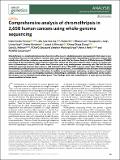Comprehensive analysis of chromothripsis in 2,658 human cancers using whole-genome sequencing
Abstract
Chromothripsis is a mutational phenomenon characterized by massive, clustered genomic rearrangements that occurs in cancer and other diseases. Recent studies in selected cancer types have suggested that chromothripsis may be more common than initially inferred from low-resolution copy-number data. Here, as part of the Pan-Cancer Analysis of Whole Genomes (PCAWG) Consortium of the International Cancer Genome Consortium (ICGC) and The Cancer Genome Atlas (TCGA), we analyze patterns of chromothripsis across 2,658 tumors from 38 cancer types using whole-genome sequencing data. We find that chromothripsis events are pervasive across cancers, with a frequency of more than 50% in several cancer types. Whereas canonical chromothripsis profiles display oscillations between two copy-number states, a considerable fraction of events involve multiple chromosomes and additional structural alterations. In addition to non-homologous end joining, we detect signatures of replication-associated processes and templated insertions. Chromothripsis contributes to oncogene amplification and to inactivation of genes such as mismatch-repair-related genes. These findings show that chromothripsis is a major process that drives genome evolution in human cancer.
Citation
Cortés-Ciriano , I , Lee , J J-K , Xi , R , Jain , D , Jung , Y L , Yang , L , Gordenin , D , Klimczak , L J , Zhang , C-Z , Pellman , D S , PCAWG Structural Variation Working Group , Park , P J & PCAWG Consortium 2020 , ' Comprehensive analysis of chromothripsis in 2,658 human cancers using whole-genome sequencing ' , Nature Genetics , vol. 52 , no. 3 , pp. 331-341 . https://doi.org/10.1038/s41588-019-0576-7
Publication
Nature Genetics
Status
Peer reviewed
ISSN
1061-4036Type
Journal article
Description
This work was supported by the European Union’s Framework Programme For Research and Innovation Horizon 2020 under the Marie Sklodowska-Curie grant agreement no. 703543 (I.C.-C.), the Ludwig Center at Harvard (I.C.-C., J.J.-K.L. and P.J.P.), K22CA193848 (L.Y.), R01CA213404 (D.S.P.) and the US National Institutes of Health Intramural Research Program Project Z1AES103266 (D.G. and L.J.K.). We thank the Research Information Technology Group at Harvard Medical School for providing computational resources and S. Ouellette in the Park laboratory for help in deploying the companion website. We acknowledge the contributions of the many clinical networks across ICGC and TCGA, who provided samples and data to the PCAWG Consortium, and the contributions of the Technical Working Group and the Germline Working Group of the PCAWG Consortium for collation, realignment and harmonized variant calling of the cancer genomes used in this study. We thank the patients and their families for their participation in the individual ICGC and TCGA projects.Collections
Items in the St Andrews Research Repository are protected by copyright, with all rights reserved, unless otherwise indicated.

